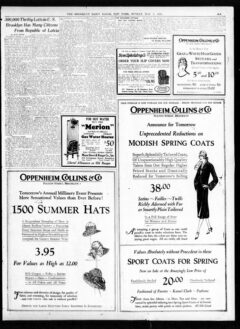A side project to determine just how many Latvian immigrants were in the United States before World War II has become a study in how press reports often exaggerated or erroneously reported population figures.

For quite a few years, my research has referenced the U.S. censuses of 1930 and 1940 in describing the Latvian immigrant population. However, I have been guilty — as have other researchers and writers — of not digging deep enough into the numbers. In an effort to rectify this, I am now working on a paper that will examine what has been reported in official data and the popular press both before and after the war.
The most surprising estimate of the size of the Latvian immigrant population is the one offered in May 1925 by the newspaper The Brooklyn Daily Eagle. Under a headline that declared “300,000 Thrifty Letts in the U.S.,” the paper reported that 6,000 Latvians lived in the New York City area and that a colony of 10,000 Latvian farmers existed in the state of Washington.1 While it might have been possible that many Latvian immigrants lived in New York, no such agricultural colony could be found in Washington. And the claim of 300,000 “thrifty Letts” in the United States, supposedly backed up by Latvian government statistics, is sheer nonsense.
Before World War II, many reports in both the American and the Latvian press cited 40,000 to 50,000 as the estimate of the immigrant population.
The number likely was significantly less. The 1930 U.S. census found 38,091 persons who reported that they or at least one of their parents was born in Latvia. However, only 7,590 individuals — including many born in Russia, Lithuania, or other countries besides Latvia — said their mother tongue was Latvian. A large percentage of those born in Latvia reported Yiddish as their mother tongue. This suggests that the ethnic Latvian population in the United States was far less than 40,000 to 50,000. Among reasons for the seemingly quick assimilation of pre-war Latvian immigrants may be that the population was so small that maintenance of ethnic institutions and culture was difficult if not impossible. Ludvigs Sēja, the Latvian ambassador to the United States, in 1927 estimated2 the number at 15,000 — just 5 percent of the number reported by The Brooklyn Daily Eagle two years earlier.
1. Jean Piper, “300,000 Thrifty Letts in U.S.; Brooklyn Has Many Citizens From Republic of Latvia,” The Brooklyn Daily Eagle, May 3, 1925, p. A9.
2. Kl., “Latvieši Savienotās Valstīs,” Latvijas Sargs, January 30, 1927, p. 1.
Accessed on 18 Apr 2024.
The article may be found online at https://straumanis.com/2017/early-latvian-population/.
